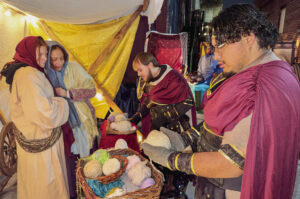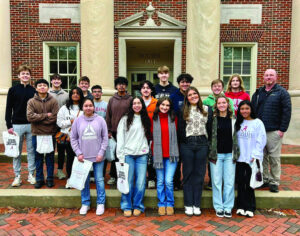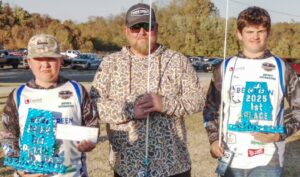Plant pollinator paradise: top tips for growing native species at home
Want beautiful blooms and butterflies in the yard? Fall is a great season for planting native species that will attract butterflies, bees and other pollinators.
The benefits include year-round beauty, ease of care and yards that are well-suited not just for people, but all manner of plants and animals native to our region.
Adam Dattilo, Tennessee Valley Authority biodiversity program coordinator, specializes in preserving plant species on TVA-managed lands.
He’s also grows pollinator-friendly flora at his home, where he tends to native gardens and maintains a grassy space for his family to enjoy.
“It frees up your time and provides habitat for native plants and animals,” Dattilo said, adding it’s “relatively easy” to change lawn care to make it pollinator-friendly.
“Grass and lawns are great for a lot of things,” Dattilo said. “Playing ball with the kids … having your friends over. But maintaining large areas of grass costs a lot of money and time.”
In his yard, he has converted small spaces – patches along his driveway, the yard’s edge, the space along the fence row – into garden plots.
The first thing to keep in mind: It’s especially important to plant native trees and flowers to give native animals food and shelter.
This will help rebuild a Valley ecosystem that’s largely been lost. Across the Southeast, 90-99 percent of grassland habitat has disappeared.
Most of this loss wasn’t intentional. On farms, people planted single crops and stopped the regular, low-intensity fires that once shaped the land. In cities, many thought of their yards as disconnected from a larger ecosystem. Grassland grew increasingly scarce.
The unwelcome advance of non-native and invasive species didn’t help, either.
Now is the time to make the yard a piece of a bigger ecosystem.
“It’s not enough to just work in parks and preserved areas,” Dattilo said. The yard is key and, collectively, a neighborhood of yards with native plants can add up to a landscape that helps animals.
When creating this habitat, structure – planting plants of different heights and kinds – is essential to attracting pollinators.
In one of Dattilo’s garden beds, 8-foot compass plants tower above fall-blooming black-eyed Susans and goldenrod, which in turn shade leaves left from spring-blooming trillium.
On a medium-height milkweed, spiky black tussock moths munch.
“I literally have plants that flower from February to November,” Dattilo said, gesturing to the asters and wild indigo in his yard. “There’s always something new.
“This is habitat for butterflies, solitary bees, potter wasps – all important pollinators. It’s amazing what you can do on just a small piece of land.”
Vegetable gardens and farms also depend on pollinators.
“Many of the fruits and vegetables we love to eat most require pollination,” Dattilo said. He pointed to his own garden patch. “Think about apples or blueberries or summer garden plants, such as zucchini or tomatoes.”
Pollinators love native trees and bushes. Dattilo’s yard looks like a park, with oak, dogwood, sumac, buckeye and other trees standing sentinel over grass and gardens.
Where can one find native species to plant?
Most homeowners will have no trouble finding native trees and flowers at local garden centers and nurseries. In rural areas, people can often just stop mowing – a seed bank of native plants may be waiting in the soil.
Curious about what’s what? Free apps such as iNaturalist can identify a species and connect to experts who can verify guesses, Melinda Watson, TVA Partnerships and Strategic Integration Program manager in Natural Resources, said.
As days get shorter and cooler, leaves fall and gardens turn brown.
But don’t rush to tidy the lawn – those seeds and fallen leaves matter to animals and soil.
This means not deadheading, or cutting off, seed heads. Goldfinch and other birds eat them through the winter, Dattilo said.
It’s also important to leave some leaves and sticks on the ground in the fall for baby insects and overwintering bees.
This doesn’t mean killing your grass.
“What we do here is rake and move leaves into piles, such as along the fence,” Dattilo said. He also rakes the leaves around the bases of trees and under plants.
The benefits are economic and ecological.
“We use those leaves as mulch … so you don’t have to pay for it the next year,” Dattilo said. “Nutrients that the trees pull out of the soil and air, you’re keeping them there. The leaves slow down the water and increase overall soil health.”
Leaving leaves on the ground is also great for insects and everything that eats them.
“Oak trees support many hundreds of species,” Dattilo said, citing the work of Doug Tallamy. Caterpillars and other insects’ young thrive in oaks. They depend on leaf piles, too.
More insects mean more birds.
At least 96% of birds – even those that eat seeds as adults – will feed their babies caterpillars found in fallen leaves.
“Just having a simple ring of leaves around that tree can help increase the beneficial insect populations in your yard,” Dattilo said. “And that can increase food and habitat for birds.”
Thinking of the big picture – from seed to pollinator to bird and beyond – means thinking about landscape-level health.
“That’s what’s in TVA’s Biodiversity Policy,” Dattilo said. “That’s what I do every day.”
TVA’s mission to serve means its team members are dedicated to biodiversity across the region.
On TVA-managed lands, environmental and sustainability specialists plant and monitor pollinator plots, restore native grasses and conduct prescribed burns.
TVA is a member of the national Power in Pollinators Initiative, which supports pollinator habitat along power line rights of way. These are the corridors that become ribbons of native grasslands, Suzanne Fisher, senior program manager of TVA Special Projects and Land Use Initiatives in Natural Resources, said.
Fisher and her team are learning about native plants all the time. They create educational signs at lands TVA manages for recreation, conservation and pollinator habitat and they host native seed giveaways at events such as National Pollinator Week, National Public Lands Day and Earth Day.
They also partner with schools, state parks and other landowners to help them create their own pollinator gardens.
Having a plot to watch throughout the seasons provides learning opportunities and gives people something they can be proud of, Holly Hoyle, senior specialist with Policy and Project Management, Natural Resources, said.&
TVA specialists are active in the Southeast Bumblebee Atlas. They also co-host a Bioblitz twice a year with partners such as Discover Life in America.
The Bioblitz is a fun way to tally plant and animal life, Watson said.
Ultimately, these efforts add habitat for pollinators. They also create lifelong advocates for the essential animals in the ecosystem.
Whether creating pollinator-friendly areas in a small yard or a vast field, no effort is too small, Hoyle said.
Fisher agrees.
“If you build it, they will come,” she said.







